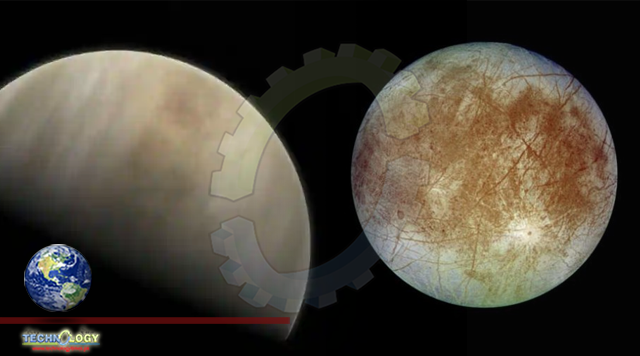Ganymede, Callisto, and Europa are three of Jupiter’s four Galilean moons, discovered by Galileo Galilei in the 1600s.

The JUICE spacecraft was launched by the European Space Agency’s (ESA) on April 14th, following a one-day delay due to lightning. It separated after 28 minutes and began an ambitious mission to investigate three moons of Jupiter, Ganymede, Callisto, and Europa, all thought to have liquid oceans beneath their icy surfaces.
The main objective, according to planetary scientist and JUICE team member Olivier Witasse, is to determine whether there are habitable environments around a large planet like Jupiter and among those icy moons. However, the JUICE team and space enthusiasts everywhere will need to be patient: It won’t be until 2031 before the spacecraft arrives in the Jovian system.
JUICE (Jupiter Ice Moons Explorer) will take a circuitous, energy-efficient route to the king of planets, boosting its speed and honing its trajectory with four “gravity assist” planetary flybys.
The first of these slingshot encounters will take place in August 2024 and involve both Earth and its moon, separated by 1.5 days. JUICE will be the first spacecraft ever to perform such a “lunar-Earth gravity assist,” and pulling it off will be a challenge.
JUICE team member and ESA scientist Alessandro Atzei said that this will be the most accurate gravity assist manoeuvre ever done. JUICE will get its second gravity assist from Venus in August 2025, then swing by Earth for additional encounters in September 2026 and January 2029.
After this final Earth encounter, the solar-powered probe will head towards Jupiter more directly, reaching the gas giant in July 2031. JUICE will then perform a flyby of the huge Jovian moon Ganymede to insert itself into Jupiter’s orbit.
JUICE’s science mission will begin six months before it reaches Jupiter, using its suite of 10 science instruments. These instruments include an optical camera system, spectrometers, radar sounders, laser altimeters, magnetometers, and particle analyzers.
Once it reaches Jupiter, the probe will study the gas giant in depth and also eye Ganymede, Callisto, and Europa. Observations of the three moons will be made up close over the course of 35 flybys between 2031 and 2034.
JUICE will fly by Callisto twice, Europa twice, Ganymede a dozen times, and Saturn a dozen times. It will also fly by Ganymede a dozen times in December 2034, marking the first time a spacecraft has ever orbited a planetary moon other than that of Earth. These flybys will involve the two most heavily cratered worlds in the solar system, Callisto, and Europa.
JUICE will also fly past Europa twice and Ganymede a dozen times, searching for possible pockets of liquid water and plumes of water vapour. This will mark the first time a spacecraft has ever orbited a planetary moon other than Earth’s.
Until JUICE’s fuel runs out, it will continue to investigate Ganymede. The epic JUICE mission will come to an end when the probe crashes into Ganymede’s icy surface as its orbit around the large moon starts to decay. The 1.6 billion euro ($1.7 billion) mission’s data collection should keep researchers busy for years to come.
According to ESA officials, “JUICE will characterise Jupiter’s ocean-containing icy moons, Ganymede, Europa, and Callisto, as planetary objects and possible habitats, explore Jupiter’s complex environment in great detail, and study the Jupiter system as an archetype for gas giants throughout the universe.”
Ganymede, Callisto, and Europa are three of Jupiter’s four Galilean moons, discovered by Galileo Galilei in the 1600s. JUICE won’t make an in-depth study of Io, the fourth and innermost Galilean moon, as it is the most volcanic body in the solar system due to the gravitational pull of Jupiter and the three other Galilean moons.
JUICE’s main body measures 13.4 feet by 9.4 feet by 14.3 feet (4.09 by 2.86 by 4.35 metres). Jupiter orbits the sun five times farther away than Earth, so JUICE’s solar panels need to be huge and efficient. After deployment, the cross-shaped arrays will cover a total area of 915 square feet (85 square metres) and convert 30% of solar energy into electricity.
However, at Jupiter, the arrays won’t even produce enough juice to power a hair dryer. Jupiter also has a powerful magnetic field, which can affect sensitive scientific instruments and trap charged particles, creating a super-intense radiation environment.
The JUICE team sealed the probe’s most sensitive equipment in a lead-lined vault due to high radiation levels. The radiation environment is less extreme around Ganymede than near Europa, so the team chose to focus more of its efforts on the giant moon.
Only two missions have orbited Jupiter to date, both of which were NASA efforts. The Galileo probe circled the planet from December 1995 to September 2003, and the Juno orbiter arrived in July 2016 and remains active today.
NASA’s Europa Clipper mission is scheduled to launch atop a SpaceX Falcon Heavy rocket in October 2024 and arrive at Jupiter in April 2030. It will remain in orbit around the gas giant, studying Europa during dozens of close flybys to reveal the thickness of the moon’s ice shell and shed light on the subsurface ocean’s life-hosting potential.
It will also serve as a scout, hunting for safe touchdown spots for another spacecraft, a lander, to look for signs of life on and just under Europa’s icy surface. The Europa lander is still a concept and is not officially on NASA’s docket yet.